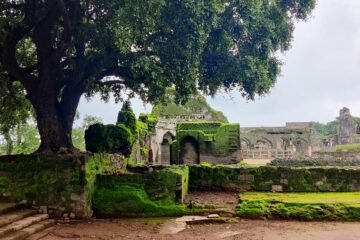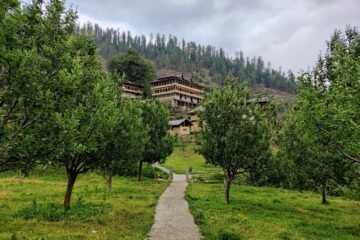Khooni darwaza is a monument which is known more for its stories rather than actual history. In a typical case of ‘reputation precedes itself’, its sensational stories have almost wiped away its original history. So much so, that people hardly know the real name of the Khooni Darwaza, or what purpose it originally served. The actual history of the gate has been taken over by the tales of violence surrounding it.
‘Kuch imaratein banti hain eeton se,
Aur kuch banti hain azaaron se…’
(Some monuments are made of bricks, and some are made of suffering)
This article tries to keep the tales of suffering aside and first looks at Khooni Darwaza from a rational lens.
The Architecture of Khooni Darwaza
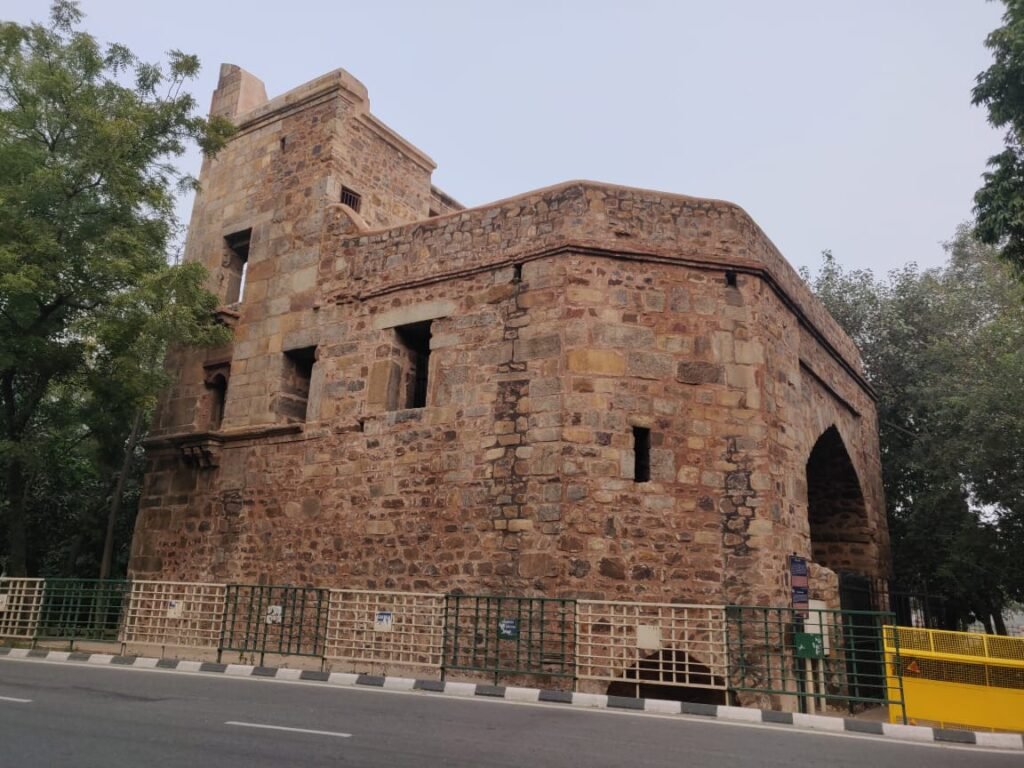
We visited Khooni Darwaza on our way back from the phenomenal Feroz Shah Kotla. The location of Khooni Darwaza, just in front of a major Medical college of India, and astride one of the main roads of India, is testament to the fact that history lives alongside the present and future in Delhi.
We stopped by the side of the road and looked across at this standalone monument, almost hidden by trees. I entered the vicinity curiously to see the backside of the infamous Khooni Darwaza. It is an imposing four-walled gate, nearly 51 feet in height and square in shape. For a gate, it is pretty large and spacious, with multiple floors inside.
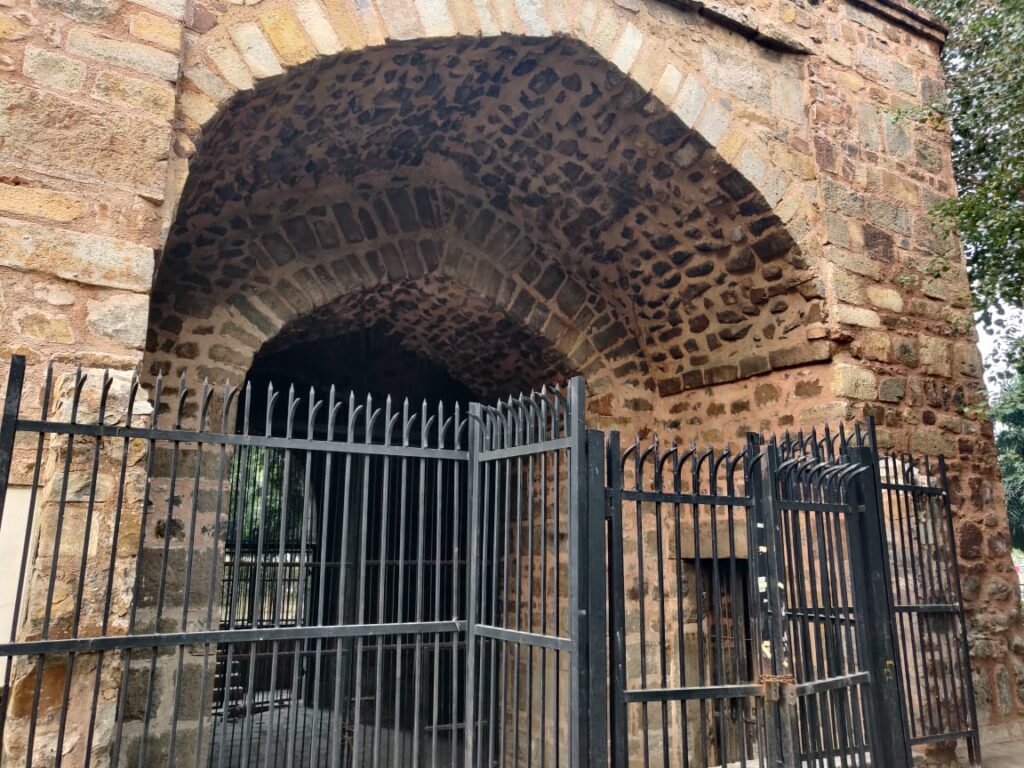
The entrance to enter the gate is blocked, but one can see staircases inside. Each staircase leads to the upper floors of this gate.
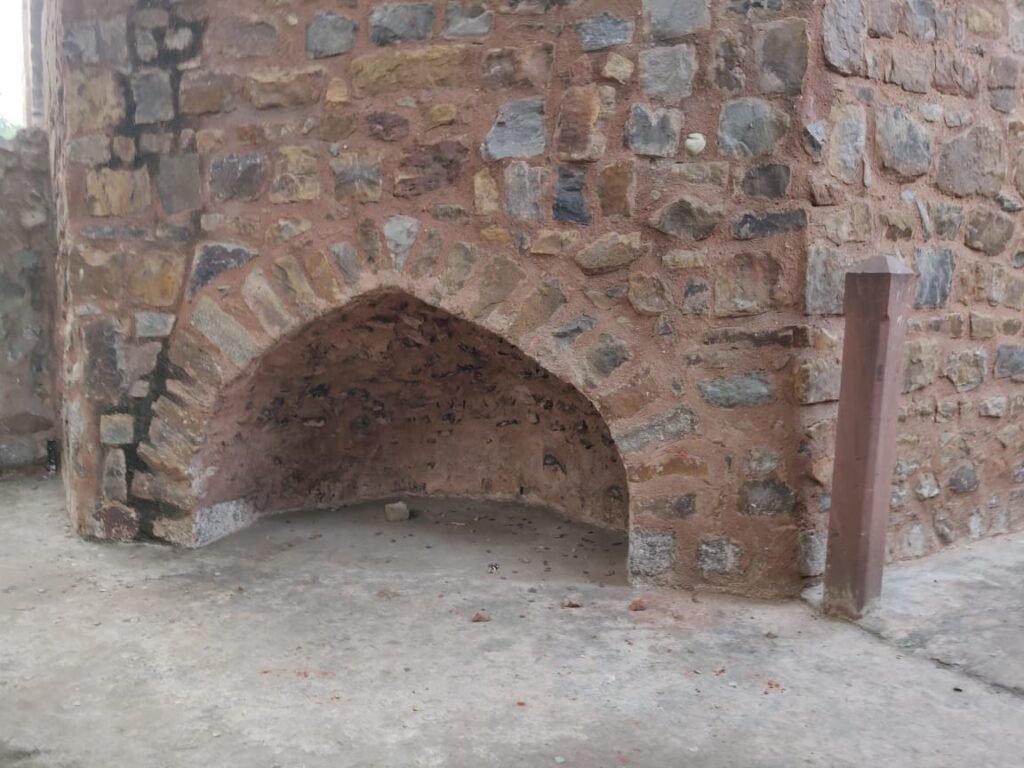
As you turn to the side of the gate, you will come across a type of niche at the ground level of the monument. It looks ornamental, but a talk with Delhi historian Vikramjit Rooprai later on told me of its real significance[1]. This ‘niche’ was actually a much taller arch of the Khooni Darwaza and was four to five feet tall instead of the small structure visible now. These arches gave strength to the tall structure of the gate.
The reason behind this change?
The ground level during the time the Khooni Darwaza was built was much lower than what it is now. This feature can also be commonly seen in other old monuments like the Adilabad fort of Delhi.
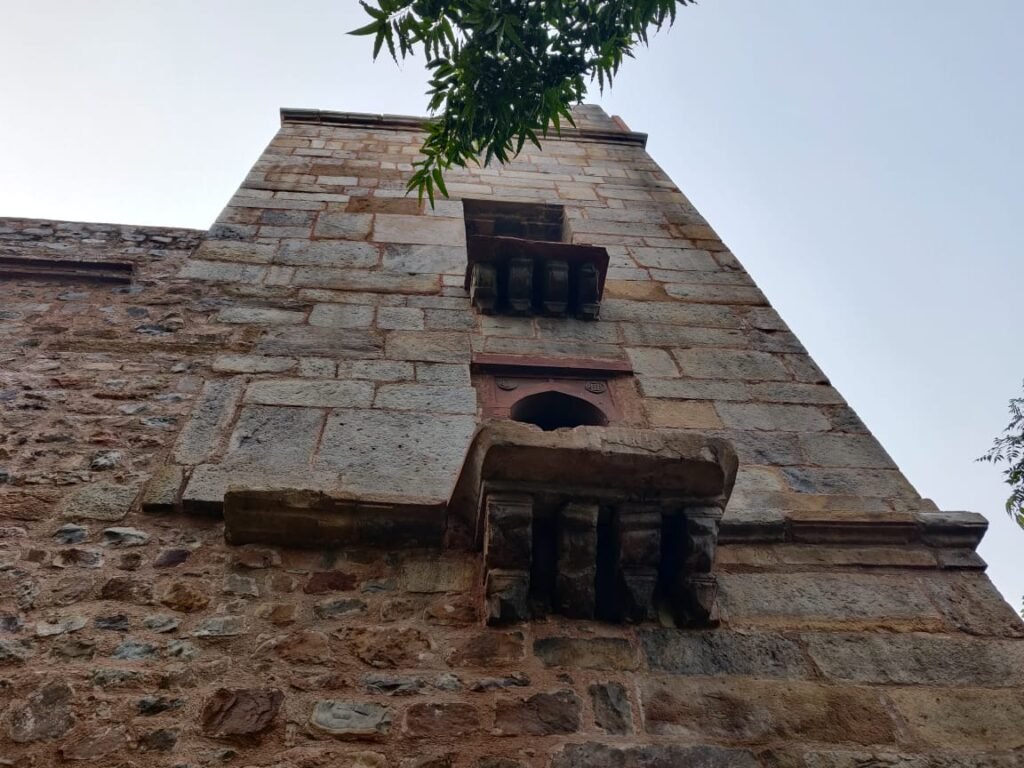
On either side of the gate are some beautiful rectangular windows with overhanging edges called chhajja supported by beautiful carved brackets. But otherwise the exterior of the gate is relatively plain.
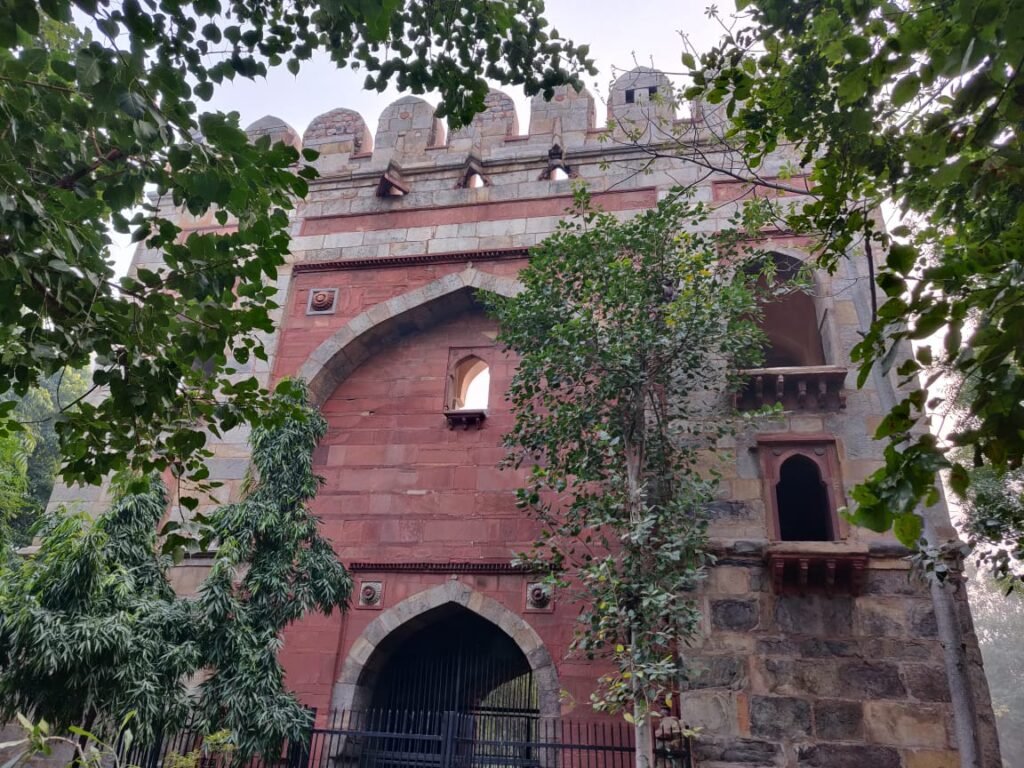
Upon reaching the front side, we saw more embellishments to an otherwise plain building. The gate has the Kangura battlement structure[2] on top, giving it the regal look of erstwhile forts. The Kangura or Kungura battlement is an important aspect of Indian monuments which serves both military and aesthetic purposes. While the petal shaped roof boundary looks regal, it also served as a place for soldiers to guard and defend the building. Below the Kangura battlement, you will see three hole-like openings. These are called damaaga, since they look like nostrils[3]. The damaagas were also structure built for defence, and could be used to pour boiling oil on enemies scaling the gate.
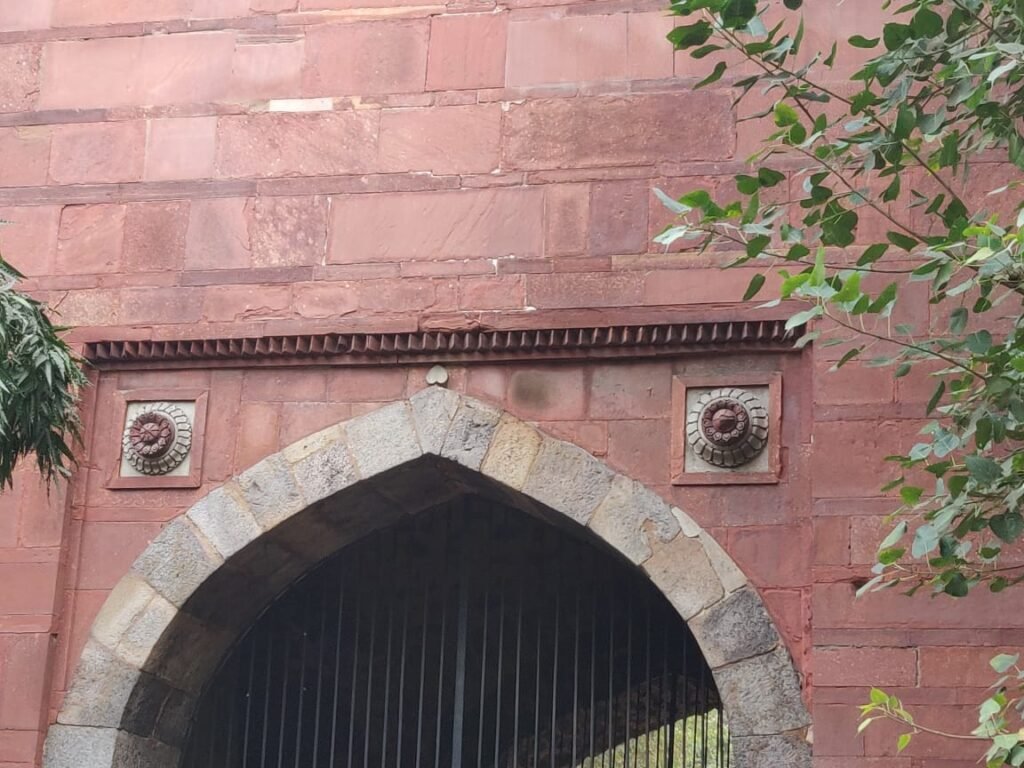
The main entrance has two flower-shaped motifs on the sides, as well as two wonderfully carved pishtaq, or niches[3]. These niches could be used to keep lamps to light up the entrance in the dark.
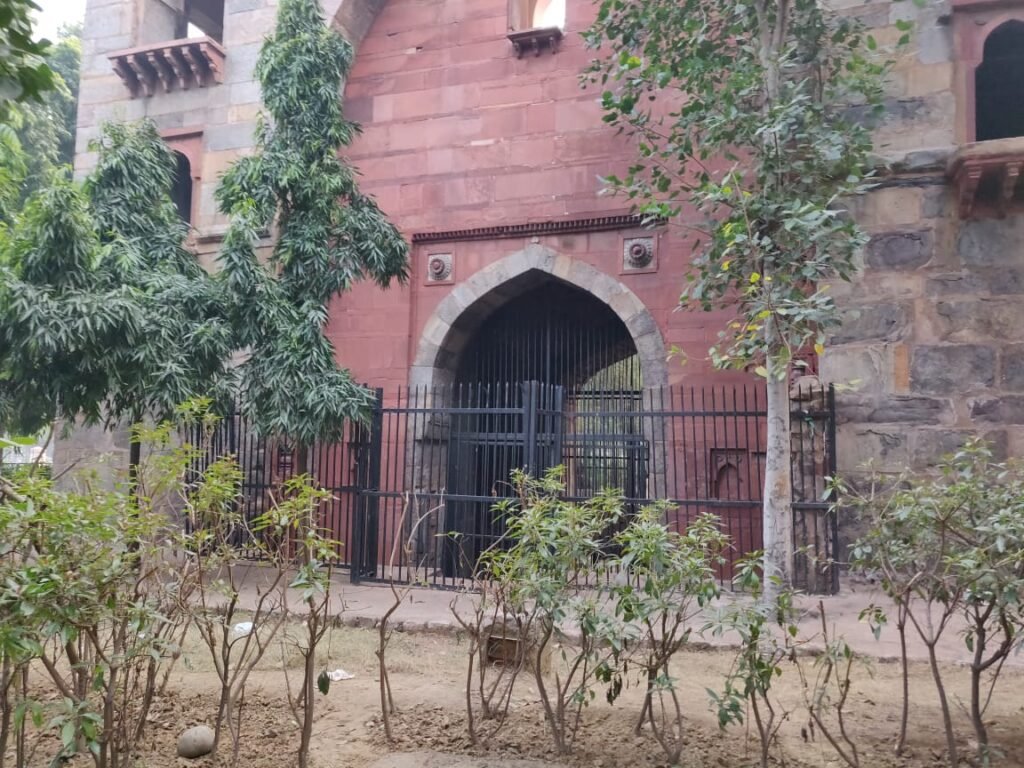
The History of Khooni Darwaza
Mughal History
Much before it became Khooni Darwaza, the grand structure we just saw was called the Kabuli Darwaza, or the gate which faced Kabul. Even though it is not located near any of the existing ruins of the historical city, it is believed to have served as one of the northern gates of Sher Shah Suri’s city Shergarh. Historians believe that Kabuli darwaza was built by Sher Shah Suri in 1540 AD, and served as one of the gates to enter the city of Shergarh.[4]
Kabuli Gate gained the infamous title of Khooni Darwaza only in later times. Some historians opine that even during the time the Sher Shah Suri, the heads of criminals were displayed at the Kabuli Gate. But there is no documented proof of this.
However, the first documented proof of bloodshed at Kabuli gate was during the time of Jahangir. Jahangir was the son of Mughal emperor Akbar, who succeeded him. His ascension was not accepted by some of the nine jewels (navratnas) of Akbar’s court. As a power tactic, Jahangir got the sons of one of the navratnas, Abdul Rahim Khan-i-khana, executed and their bodies were left at Kabuli Darwaza to rot.
Some years later, in yet another succession battle, Shah Jahan’s son Aurangzeb displayed the head of his brother Dara Sikhoh at the Kabuli Darwaza.
While there is some debate about this, it is said that the gate saw another spate of bloodshed during Nadir Shah’s attack on Delhi. However, many historians believe that this incident happened at another similarly named location in Shahjahanabad (known as Purani Dilli these days).
The moment when Kabuli Darwaza entered the annals of history as Khooni Darwaza came on 22nd September 1857. After the last Mughal Emperor of India Bahadur Shah Zafar surrendered, his family members were being transported from Humayun’s Tomb by British Officer Major William Hodson. During this transportation, Major Hodson reported that he was surrounded by hundreds of protesting Indians. As a way of defending himself and his soldiers, he ordered the sons of Bahadur Shah Zafar, Mirza Mughal and Mirza Khizr Sultan and his grandson, Mirza Abu Bakht, to strip naked. The three men were then shot dead by Major Hodson, and their bodies were put on public display in Chandni Chowk for three days.[5]
Modern History
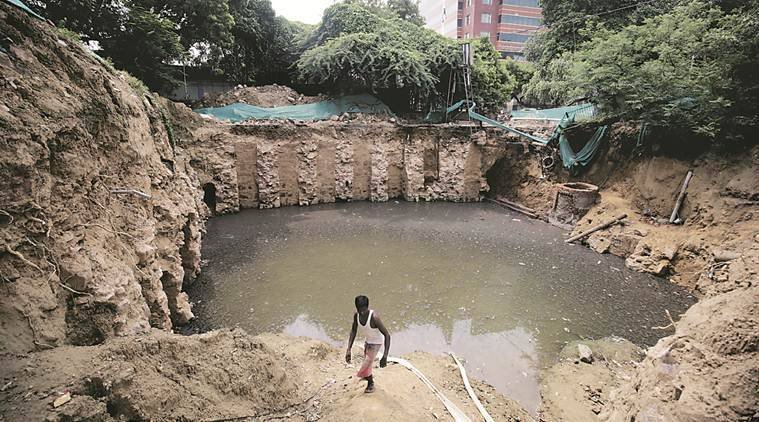
The violent trail of Kabuli Darwaza did not end here. In 2019, a 19th Century wall was discovered at Maulana Azad Medical College right next to Khooni Darwaza. These walls are the remnants of a Central Jail built by the Britishers, who in turn had made this jail from the remains of a 16th century sarai (inn) built by Shaikh Farid, the governor of Gujarat and later Punjab during Jehangir’s reign. It was in this jail that freedom fighters involved in the Hardinge assassination attempt were imprisoned.[6]
In more recent times, a number of refugees were killed here during the partition riots of 1947. Even more recently in 2002, a medical student was raped within this monument leading to ASI closing the entrance to the monument interiors forever.
One can only hope this closure of gates also closes the flow of violence that Khooni Darwaza has witnessed in almost 500 years, and it once again is able to tell the tales of its important past when grand caravans traversed through its roof to travel to the faraway lands of Kabul…
References
- Conversation with Delhi Historian Vikramjit Rooprai.
- The Khooni Darwaza, Archronicle.
- A Quick Lesson in Mughal Architectural Elements, www.madhulikaliddle.com
- The Khooni Darwaza, en.wikipedia.org
- Dalrymple, William. The Last Mughal. p. 397-398
- Part of 19th Century Jail Wall Dug Up at Hospital in Delhi, Aug 18 2019, Indian Express
